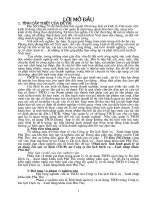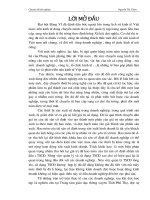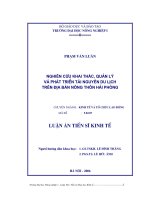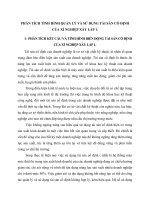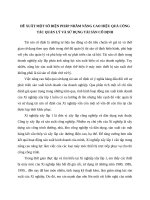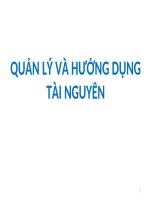QUẢN LÝ VÀ HƯỞNG DỤNG TÀI NGUYÊN, CHAPTER I INTRODUCTION
Bạn đang xem bản rút gọn của tài liệu. Xem và tải ngay bản đầy đủ của tài liệu tại đây (179.19 KB, 49 trang )
QUẢN LÝ VÀ HƯỞNG DỤNG
TÀI NGUYÊN
1
1. Introduction
•
Natural Resources?
•
Natural Resource Management?
•
Sustainable Management?
2
What is Natural Resource Management?
•
NRM involves interaction (e.g. use, preservation,
manipulation) of human with natural resources
(land, water, forests and biological resources base).
•
NRM rest on principles of ecosystem dynamics,
adequate legal frameworks and property rights
arrangements, and respect for customs and
traditions governing resource access and use.
•
NRM has 3 major dimensions: ecological,
economical, and social.
3
Ecological dimension
Abiotic component: non-living environment
- e.g. climate, soil, water.
Biotic component: Living organisms – e.g.
plants, animals.
4
Economical dimension
•
Economic viability is the major concern.
•
Involves understanding economic
behavior, the costs and benefits of
different resource use arrangements.
5
Social dimension
•
Resource use and constraints, including social
equity in allocation and use of resources.
•
Institutions governing the use and
management of the natural resource.
•
Effect of policies at macro level, legal
framework, and property rights arrangement.
•
Reduction of social conflict.
•
Information flow and management.
6
•
Natural Resource Managers:
–
require technical skills and knowledge
about biophysical processes as well as
the social and economic components.
–
need to understand how these different
dimensions of NRM interact, and
–
need to harness existing and new
techniques to solve natural resource
issues of the future.
7
What is sustainability?
•
A pattern of resource use that can
continue without a decrease in future.
•
Criteria for sustainability differ with the
difference in resources.
•
Sustainability can be viewed from (i)
social, (ii) economical, or (iii) ecological
perspective.
8
The Concept of “Sustainable Development”
Introduced by WCED (1983).
WCED definition of sustainable
development:
“Development that meets the needs of the
present without compromising the ability of
future generations to meet their own
needs”.
9
Principles of sustainable activity
•
adaptable to change
•
integration of ecological, economic, and
social factors
•
does not foreclose options to future
generations
•
based on public support and local solutions
•
the costs and benefits of resource
management are shared by all concerned
10
The essence of sustainable development
Developing integrated solutions based on
harmony between the economy, society
and the environment.
11
.
12
Sustainability of Natural Resources
Renewable natural resources are the basis
for life and their exploitation constitutes
the primary source of livelihoods for most
of the world's population.
Sustainable management of these
resources is essential for more sustainable
and equitable development.
13
14
2. Environmental Sociology and Sociology of
Natural Resources
15
Why important?
•
The two fields are quite different in terms of
origins and institutional characteristics.
•
It is useful for natural resources managers to
know the general or basic differences
between the two fields so that they can
understand the literature and contribute to
theoretical debates.
16
Dimension Envi.
Sociology
NR Sociology
Origin Environmental
movement;
early 1970s
Rural sociology;
mid-1960s
Main features
of the
environment
stressed
Pollution,
resource
scarcity, global
environment
Conservation,
carrying capacity
Definition of
sustainability
Reduction of
pollution levels
and raw
material usage
Sustained yields
of NRs, social
equity, conflict
reduction
17
Dimension Envi.
Sociology
NR Sociology
Practitioners Liberal arts
sociologists
Social scientists
working with NRM
agencies, rural
sociologists
Scale/unit of
analysis
Nation,
Metropolitan
focus
Individuals,
community or region,
non-metropolitan
focus
Focus Explaining
environmental
degradation
Improving public
policy, minimizing
environmental
impacts and conflicts
18
Dimension Envi.
Sociology
NR Sociology
Theoretical
commitments
Highly
theoretical
De-emphasis on
social theory
Conceptual
orientation
Role of the
state in
influencing
environmen
tal abuse
and
degradation
People-resource
interactions and
their outcomes
19
Is cross-fertilization between ES & SNR possible?
•
Some social scientists (e.g. Belsky 2002) think
that it is possible and necessary.
•
Political ecology, community based
conservation, and sustainable livelihoods
could work as “bridging” areas between the
two fields.
20
Political Ecology
The attempt to understand the political sources,
conditions and ramification of environmental change
(Bryant, 1992).
•
Maintains NR sociology’s concern with local or
traditional knowledge,
•
Opens up the possibility of providing detailed
understanding of ecological processes, and
•
Highlights the significance of political struggles
between western science and alternative knowledge
systems.
21
Community Based Conservation
•
Links rural community development (i.e.
concerns of NR sociology) with critiques of
state-led protected area management, global
environmental problems, and environmental
justice (i.e. concerns of environmental
sociology).
22
Sustainable livelihoods (or sustainable utilization)
“is one which can cope with and recover from stress
and shocks, maintain or enhance its capabilities and
assets, and provide opportunities for next
generation; and which contributes net benefits to
other livelihoods at the local and global levels and in
the short and long run” (Chambers and Conway, 1992).
This concept is linked to the community
conservation, but also attempts to incorporate a
more dynamic ecological understanding.
23
Critique
•
Some argue that both the fields fail to address
many social concerns including those related
to race, gender, and class.
•
They emphasize for an alternative
environmental movement concerned with
social justice and fundamental social change.
•
Criticism is mainly coming from: Deep
Ecologists, Eco-feminists, and Social
Ecologists.
24
Deep Ecologists
•
Problem identified: Anthropocentrism (chủ
nghĩa trọng nhân - human-centeredness) is a
misguided way of seeing things.
•
Solution proposed: Human self-realization.
25
Eco-feminists
•
Problem identified: Androcentrism (Chủ nghĩa
vị nhân - man-centeredness), which is
responsible for:
–
the destruction of the biosphere, and
–
the development of authoritarian (d practices,
both socially and environmentally.
•
Solution proposed: Egalitarian (người theo
chủ nghĩa quân bình) social relationships.



